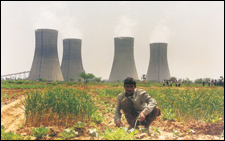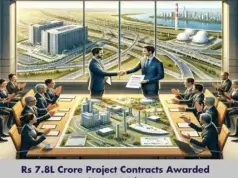Precast or prefabricated products like autoclaved aerated concrete blocks provide a good solution to tackle many on-site issues as they can be installed quickly, consume less time and labour, reduce on-site wastage, require less storage space, and consume fewer resources. Shailendra Chouksey, Whole-time Director, JK Lakshmi Cement Ltd, looks at the future of Indian construction.
In the Indian economy, construction accounts for approximately 40 per cent of the development investment during the past 50 years and contributes to around 8.5 per cent of GDP. The Indian construction industry, which is highly fragmented, provides employment to over three crore people and creates assets of more than Rs.20,000 crore. Civil construction requirements vary across various usages. Construction of houses needs about 75 per cent of civil construction work, followed by roads (60 per cent), airports and ports (50 per cent), and industrial projects in the range of 40 per cent.
Increased urbanisation, economic development, improved living standards, increased industrialisation and infrastructure investments have led to high growth of the Indian construction industry. Due to the sustained demand, requirement of steel and cement the two basic materials used in construction; have increased drastically. The construction industry has seen a considerable jump in construction costs over the last decade because of various factors along with increase in labour costs. Rising costs and political problems have also seen construction delays over the past few years.
Amidst this scenario, other than material cost escalations, the construction industry today faces challenges on various fronts such as regulatory hurdles, land acquisition, lack of trained manpower, inadequate logistics, material wastages etc. Genuine concerns on safety, sustainability and environment are forcing industry to adapt and to adopt various technology intensive methods, processes, tools and products such as disaster resistant construction, water and waste management, energy conservation etc. All these macro drivers are challenges from all fronts for the construction industry.
Another major challenge is to improve competitiveness and optimise projects cost so as to maintain their position in face of stiff global competition knocking their doors.
In light of above, all the stakeholders of the Indian construction industry would have to implement new construction technology so as to deliver on 5 S’ of construction — Speed, Strength Safety, Sustainability, and Savings.
 Considering the challenges of the industry and drawing lessons from the concept of modular design, I firmly believe that precast or prefabricated products provide a good solution to tackle many of the on-site issues. These types of products can be installed quickly, consume less time and labour, reduce on-site wastage, require less storage space, consume fewer resources, and be customised off-line to suit various needs.
Considering the challenges of the industry and drawing lessons from the concept of modular design, I firmly believe that precast or prefabricated products provide a good solution to tackle many of the on-site issues. These types of products can be installed quickly, consume less time and labour, reduce on-site wastage, require less storage space, consume fewer resources, and be customised off-line to suit various needs.
This makes AAC (autoclaved aerated concrete) blocks the future of Indian construction and real estate sectors, as they also support on-time delivery of any project. The very fact that AAC block has fly ash, a byproduct of the power industry and cement as its base content, makes it a green building product, as compared to the earthen soil that is used in the manufacture of traditional bricks. The manufacturing process, too, remains leaner as it works on zero wastage strategy.
Gone are the days when the construction industry would rely upon conventional bricks for constructing buildings for residential and commercial purposes as they are not only becoming costlier to produce and use but they are also are creating soil erosion which is dangerous for our future.
However, AAC blocks are relatively new in India as compared to the Western countries, where these blocks are used extensively. Keeping pace with the need of the industry JK Lakshmi Cement has ventured into production of AAC blocks using German technology. To be known as JK SmartBlox , this state-of-the-art plant is located at Jharli, Haryana, with an annual capacity of around 1.5 lakh cum metre and is equipped with the latest advance technology such as green separation and horizontal autoclaving.
Construction using AAC blocks help to save wall construction time by 30 per cent approximately. Its low density and adequate strength helps to save steel requirement up to 15 per cent and reduces cement consumption by around 18 per cent. The large face of the block helps to reduce the number of joints and mortar usage. Also, good insulation properties can reduce power consumption by almost 28 per cent.
|
There are several other benefits of using AAC blocks which makes it the most technologically advanced product. It is highly adaptable to a variety of architectural designs and can easily be engineered to meet structural load requirements. It reduces jobsite waste if components are pre-made and tailored to building-specific features. The waste created on-site can be recycled or disposed of in a regular waste bin. It does not rot, warp, corrode, or otherwise decompose, providing a very durable material that will last for many years.
AAC blocks provide walls that are very dimensionally accurate and consistent. These blocks have good workability which can be cut with a handsaw and sculpted with a rasp, creating endless design possibilities. It is manufactured from common and abundant natural raw materials and the finished product is up to twice the volume of the raw materials used, making it extremely resource-efficient and environmentally friendly. The energy consumed in the production process is only a fraction compared to the production of other materials. The manufacturing process emits no pollutants and creates no byproducts or toxic waste products.
Real estate developers are now increasingly turning to greener avenues, egged by the ready availability of environment-friendly building materials and with unique feature of tongue and groove and hand grips, AAC block is the most environment friendly product which is available in the walling space today.
However, adapting and adopting such new technology would not be easy. There should be all-round effort to increase awareness about theses products across all stakeholders – occupants, developers, consultants, architects, government agencies etc. Government should incentivise use of such products which help to deliver projects in time.











